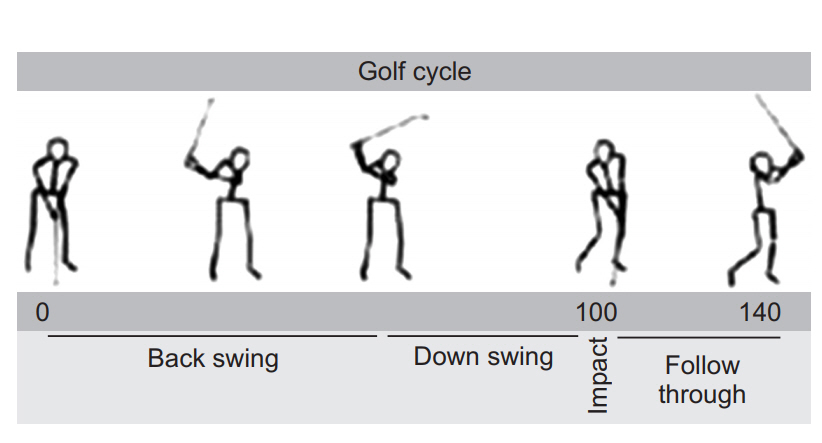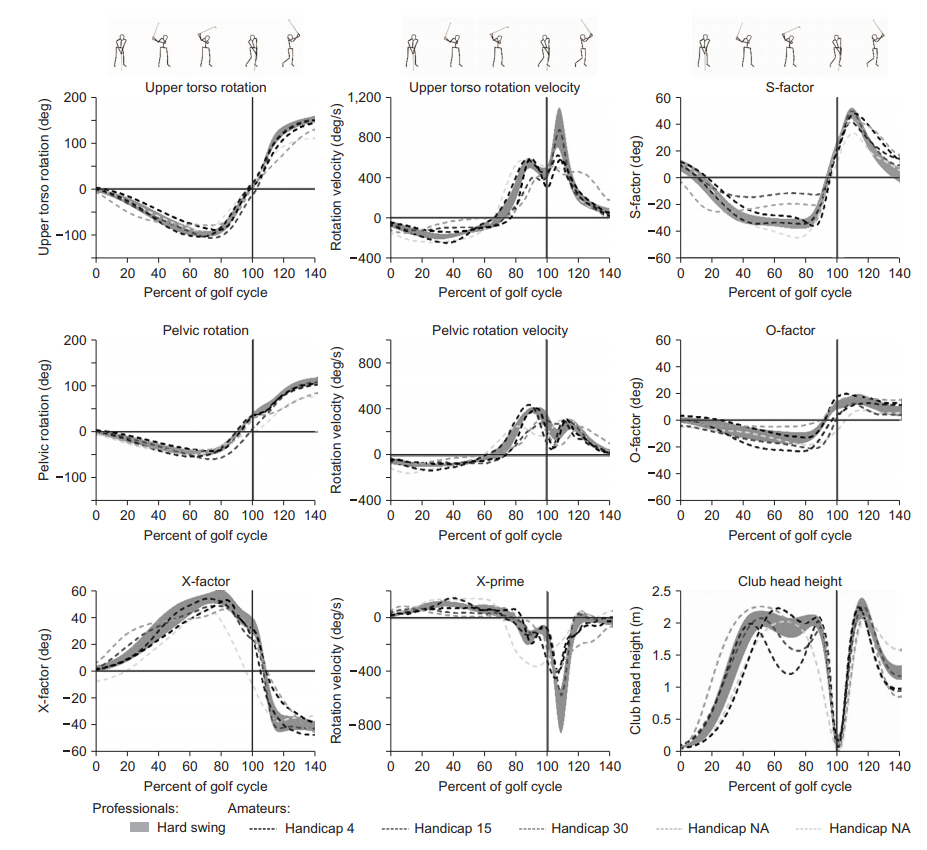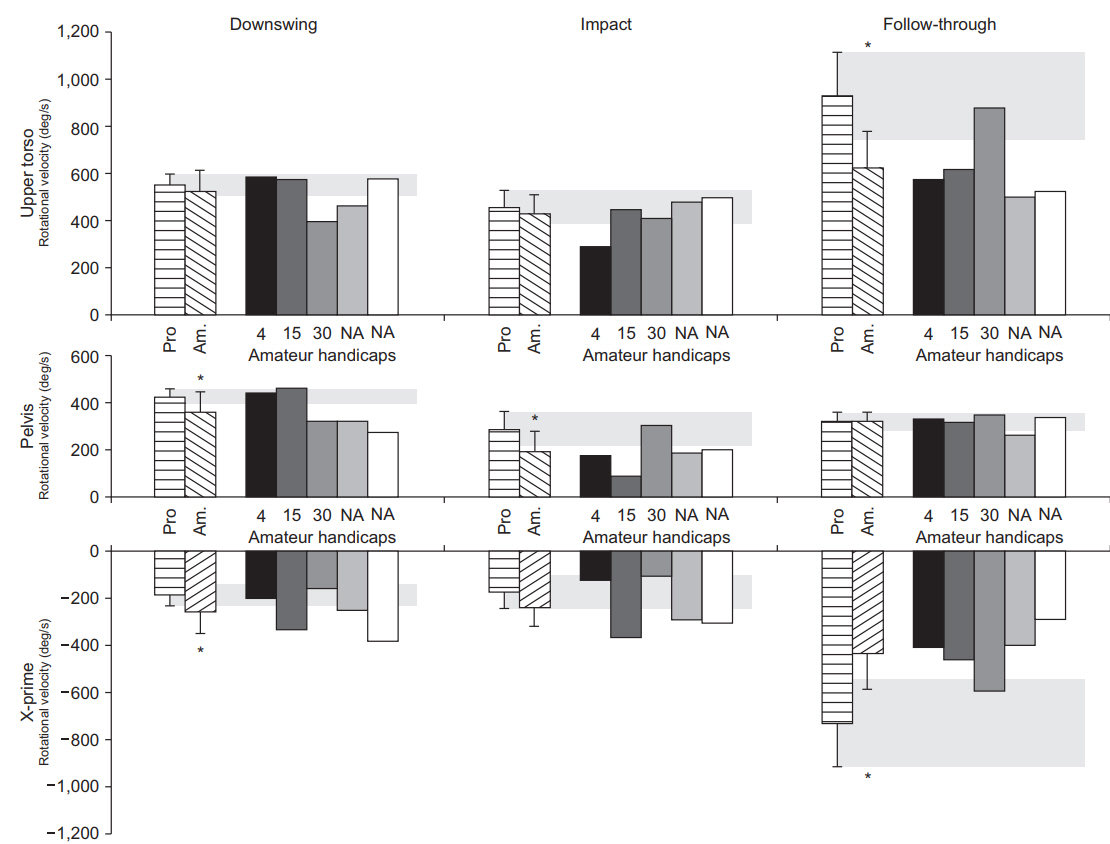Ann Rehabil Med.
2018 Oct;42(5):713-721. 10.5535/arm.2018.42.5.713.
Golf Swing Rotational Velocity: The Essential Follow-Through
- Affiliations
-
- 1Department of Orthopaedic Surgery, Stanford University School of Medicine, Stanford, CA, USA. jessica.rose@stanford.edu
- 2Motion & Gait Analysis Laboratory, Lucile Packard Children’s Hospital, Stanford, CA, USA.
- 3Department of Mechanical Engineering, University of Washington, Seattle, WA, USA.
- 4Department of Orthopaedic Surgery, Medical College of Wisconsin, Milwaukee, WI, USA.
- KMID: 2429200
- DOI: http://doi.org/10.5535/arm.2018.42.5.713
Abstract
OBJECTIVE
To evaluate if shoulder and pelvic angular velocities differ at impact or peak magnitude between professional and amateur golfers. Golf swing rotational biomechanics are a key determinant of power generation, driving distance, and injury prevention. We hypothesize that shoulder and pelvic angular velocities would be highly consistent in professionals.
METHODS
Rotational velocities of the upper-torso and pelvis throughout the golf swing and in relation to phases of the golf swing were examined in 11 professionals and compared to 5 amateurs using three-dimensional motion analysis.
RESULTS
Peak rotational velocities of professionals were highly consistent, demonstrating low variability (coefficient of variation [COV]), particularly upper-torso rotational velocity (COV=0.086) and pelvic rotational velocity (COV=0.079) during down swing. Peak upper-torso rotational velocity and peak X-prime, the relative rotational velocity of uppertorso versus pelvis, occurred after impact in follow-through, were reduced in amateurs compared to professionals (p=0.005 and p=0.005, respectively) and differentiated professionals from most (4/5) amateurs. In contrast, peak pelvic rotational velocity occurred in down swing. Pelvic velocity at impact was reduced in amateurs compared to professionals (p=0.019) and differentiated professionals from most (4/5) amateurs.
CONCLUSION
Golf swing rotational velocity of professionals was consistent in pattern and magnitude, offering benchmarks for amateurs. Understanding golf swing rotational biomechanics can guide swing modifications to help optimize performance and prevent injury.
Keyword
MeSH Terms
Figure
Reference
-
1. Evans K, Refshauge KM, Adams R. Measurement of active rotation in standing: reliability of a simple test protocol. Percept Mot Skills. 2006; 103:619–28.
Article2. Evans K, Refshauge KM, Adams RD, Barrett R. Swing kinematics in skilled male golfers following putting practice. J Orthop Sports Phys Ther. 2008; 38:425–33.
Article3. Horan SA, Evans K, Morris NR, Kavanagh JJ. Thorax and pelvis kinematics during the downswing of male and female skilled golfers. J Biomech. 2010; 43:1456–62.
Article4. Ball KA, Best RJ. Different centre of pressure patterns within the golf stroke I: cluster analysis. J Sports Sci. 2007; 25:757–70.
Article5. Ball KA, Best RJ. Different centre of pressure patterns within the golf stroke II: group-based analysis. J Sports Sci. 2007; 25:771–9.
Article6. Gluck GS, Bendo JA, Spivak JM. The lumbar spine and low back pain in golf: a literature review of swing biomechanics and injury prevention. Spine J. 2008; 8:778–88.
Article7. Hume PA, Keogh J, Reid D. The role of biomechanics in maximising distance and accuracy of golf shots. Sports Med. 2005; 35:429–49.
Article8. Teu KK, Kim W, Fuss FK, Tan J. The analysis of golf swing as a kinematic chain using dual Euler angle algorithm. J Biomech. 2006; 39:1227–38.
Article9. Zheng N, Barrentine SW, Fleisig GS, Andrews JR. Kinematic analysis of swing in pro and amateur golfers. Int J Sports Med. 2008; 29:487–93.
Article10. Statistic Brain Research Institute. Golf player demographic statistics 2012 [Internet]. Los Angeles: Statistic Brain Research Institute;c2018. [cited 2018 Sep 15]. Available from: http://www.statisticbrain.com/golfplayer-demographic-statistics/.11. Meister DW, Ladd AL, Butler EE, Zhao B, Rogers AP, Ray CJ, et al. Rotational biomechanics of the elite golf swing: benchmarks for amateurs. J Appl Biomech. 2011; 27:242–51.
Article12. Zheng N, Barrentine SW, Fleisig GS, Andrews JR. Swing kinematics for male and female pro golfers. Int J Sports Med. 2008; 29:965–70.
Article13. Farrally MR, Cochran AJ, Crews DJ, Hurdzan MJ, Price RJ, Snow JT, et al. Golf science research at the beginning of the twenty-first century. J Sports Sci. 2003; 21:753–65.
Article14. Fradkin AJ, Cameron PA, Gabbe BJ. Golf injuries: common and potentially avoidable. J Sci Med Sport. 2005; 8:163–70.15. Werner D. Driving toward prevention. Phys Ther Prod. 2000; 5:12–5.16. Fradkin AJ, Cameron PA, Gabbe BJ. Is there an association between self-reported warm-up behaviour and golf related injury in female golfers? J Sci Med Sport. 2007; 10:66–71.
Article17. Gosheger G, Liem D, Ludwig K, Greshake O, Winkelmann W. Injuries and overuse syndromes in golf. Am J Sports Med. 2003; 31:438–43.
Article18. Batt ME. A survey of golf injuries in amateur golfers. Br J Sports Med. 1992; 26:63–5.
Article19. Batt ME. Golfing injuries: an overview. Sports Med. 1993; 16:64–71.20. Finch C, Sherman C, James T. The epidemiology of golf injuries in Victoria, Australia: evidence from sports medicine clinics and emergency department presentations. In : Farrally MR, Cochran AJ, editors. Science and Golf III: Proceedings of the 1998 World Scientific Congress of Golf. Champaign: Human Kinetics;1999. p. 73–82.21. McHardy A, Pollard H, Luo K. Golf injuries: a review of the literature. Sports Med. 2006; 36:171–87.22. Theriault G, Lachance P. Golf injuries: an overview. Sports Med. 1998; 26:43–57.23. Lindsay D, Horton J. Comparison of spine motion in elite golfers with and without low back pain. J Sports Sci. 2002; 20:599–605.
Article24. McCarroll JR, Gioe TJ. Professional Golfers and the Price They Pay. Phys Sportsmed. 1982; 10:64–70.
Article25. Myers J, Lephart S, Tsai YS, Sell T, Smoliga J, Jolly J. The role of upper torso and pelvis rotation in driving performance during the golf swing. J Sports Sci. 2008; 26:181–8.
Article26. Horan SA, Kavanagh JJ. The control of upper body segment speed and velocity during the golf swing. Sports Biomech. 2012; 11:165–74.
Article27. McHardy A, Pollard H. Muscle activity during the golf swing. Br J Sports Med. 2005; 39:799–804.28. Lindsay DM, Horton JF. Trunk rotation strength and endurance in healthy normals and elite male golfers with and without low back pain. N Am J Sports Phys Ther. 2006; 1:80–9.29. Parziale JR. Healthy swing: a golf rehabilitation model. Am J Phys Med Rehabil. 2002; 81:498–501.30. Parziale JR, Mallon WJ. Golf injuries and rehabilitation. Phys Med Rehabil Clin N Am. 2006; 17:589–607.
Article
- Full Text Links
- Actions
-
Cited
- CITED
-
- Close
- Share
- Similar articles
-
- Electromyographic Analysis of Left Leg Muscle Activity during Golf Driver Swing
- Golf-related Spine and Lower Extremity Injury
- Effects of Auditory Information and Expertise on the Kinematic Variables of Lower Extremity during Golf Iron Swing
- Partial Tear of Pronator Teres Muscle in Amateur Golfer: A Case Report
- Asymmetry of the Isokinetic Trunk Rotation Strength of Korean Male Professional Golf Players





